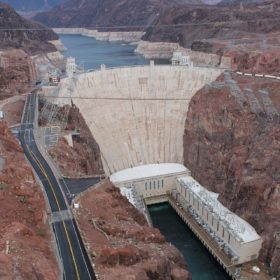
Scientists at Princeton have found solar and wind energy offer the added environmental benefit of reducing water usage, by comparison with hydroelectric dams. Their findings, say the researchers, could have a positive impact on groundwater sustainability in drought-prone regions such as California, where they conducted a case study.
Researchers led by the University of Princeton have found that, alongside renewable energy’s well-known carbon emission reduction benefits, solar and wind power also keep more water in the ground than hydroelectric facilities. The result is less pressure on the water supply, freeing up more of the resource for food production.
“Traditionally, the social value of solar and wind energy has mostly been focused on air pollution mitigation and carbon emission reductions,” said Xiaogang He, lead author of the study at Princeton and soon-to-be assistant professor in the Department of Civil and Environmental Engineering at the National University of Singapore. “However, if we look at the problem from a different angle – like the water-food-energy nexus – then our paper identifies some unrecognized and under-appreciated affects that have been overlooked in past studies.”
Recent reports have noted the potential of PV powered desalination to alleviate water shortage but few have highlighted the technology’s potential to contribute to that aim simply by not using water. Most other forms of power generation rely on water or steam to spin turbines.
The pay-off
In their paper, published in Nature Communications, the researchers create a ‘trade-off frontier framework’ – an analytical tool often used in policy development – to quantify the benefits of increased solar and wind generation capacity for groundwater sustainability, and to identify the optimal way to maximize hydroelectric generation and agriculture while minimizing groundwater depletion.
The paper takes California as a case study thanks to its status as an agricultural hub for the United States and as a leader in the deployment of solar and wind generation. The state suffered drought from 2012-217, leading to widespread reliance on unsustainable groundwater stores. While the results focus on California, He says the framework developed by his team could be used by policymakers elsewhere.
The researchers noted, 54% of the world’s hydropower plants compete with agriculture for water use. The two sectors rarely collaborate on water management schemes and have quite different needs – hydropower stores water in reservoirs to maintain a head for power generation while farms need water released for irrigation downstream.
Aquifers threatened
He and his team argue further deployment of solar and wind, as well as integrated management of water resources can, even in drought conditions, reduce the use of groundwater drawn from aquifers that can take years to refill. The authors note the importance of integrated modelling, taking into account the intertwined issues of water, food and energy. The researchers say in California, action to deploy more solar and wind and to strictly regulate the use of groundwater should be taken sooner rather than later.
“Our results also suggest that policymakers need to take the long-term outlook of groundwater depletion into consideration when planning further deployment of solar and wind energy,” said He. “If groundwater aquifers keep getting depleted in the future, then the added value of penetrating solar and wind energy will largely decrease.”
Lắp đặt điện mặt trời Khải Minh Tech
https://ift.tt/2X7bF6x
0906633505
info.khaiminhtech@gmail.com
80/39 Trần Quang Diệu, Phường 14, Quận 3
Lắp đặt điện mặt trời Khải Minh Tech
https://ift.tt/2ZH4TRU
Không có nhận xét nào:
Đăng nhận xét